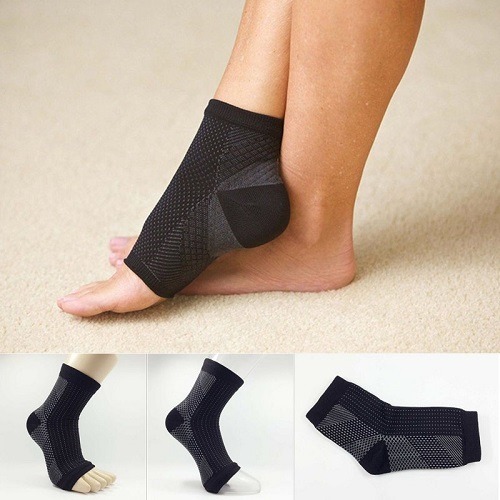All You Need To Know About Bunions
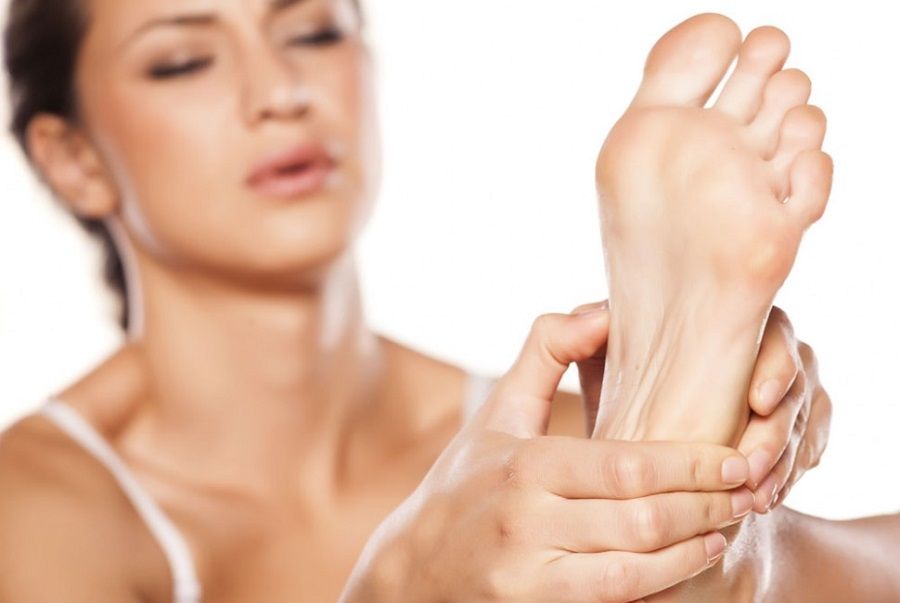
A bunion can be described as a bump on the side of your big toe. However, an important thing to remember here is that bunions are more than a common ‘foot’ deformity. The bony bump you find at the base of the big toe can be extremely painful.
This point is also vulnerable to excessive pressure (after all your entire body weight will be exerted on the bunion even if you take the smallest steps). Not to forget, there will be friction resulting from narrow and tight footwear.
First – Check Out The Infographic

Share This Image On Your Site
You put great pressure on your big toe as you start walking and you can check this easily for yourself. Stand up and start walking. Now notice the pressure you put on your big toe and the area surrounding it – you felt the pressure, right?

Problems with your little (pinky) toe is generally of minimal consequence but problems in the HALLUX or the big toe is somewhat a serious concern. Because your big toe is the last part of your foot to push off the ground with each step you take, it is responsible for balancing almost 40% of your body’s weight.
What Does A Bunion Look Like?
HALLUX VALGUS is the scientific name for a bunion. It forms when your big toe starts moving towards the second toe. As a result, the base of your big toe is pushed outwards. Because a bunion forms at the base of the big toe or the point where your toe bends as you walk, your entire body weight resting on the bony bump makes it even more painful to walk normally.
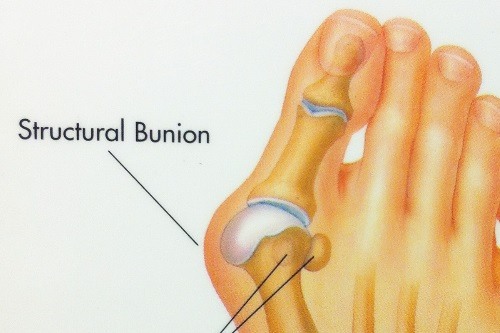
The angular, bony bump on the side of your foot i.e. at the base of the big toe can change the shape of your foot. The joint of your big toe becomes stick and tends to stick out. The skin covering the bunion appears red and sore.
When a bunion develops, your big toe points inwards towards the second toe and the base of the joint points outwards. The scientific name of the bunion i.e. HALLUX VALGUS literally means ‘big toe turned away from the midline of the body.’
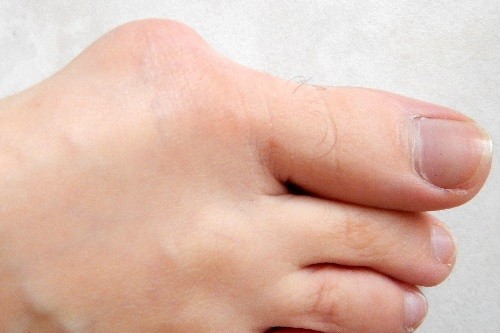
As you can guess, bunions change the bone network in your foot and the shoes you use might not be able to accommodate the abnormal protrusion. Over the period, bursa or the fluid filled sac that surrounds and cushions the bunion becomes inflamed and this is the point when your joint becomes stiff and painful.
Another problem with bunion is that your other toes are not designed to carry as much weight as the big toe. These toes are not as strong and over the period, bunions can cause other toes to shift positions as well.
What Causes A Bunion?
You should blame your genetics first and your footwear next. That’s right. Even though it sounds surprising, bunions tend to run in families. You are more likely to develop a bunion if your foot framework is prone to inflammatory joint disease or you have arthritis or flat feet.
Your choice of footwear plays an important part as well. If you love wearing shoes that squeeze your toes close especially like many trendy pointed peep toe sandals do, you increase your chances of developing a bunion.
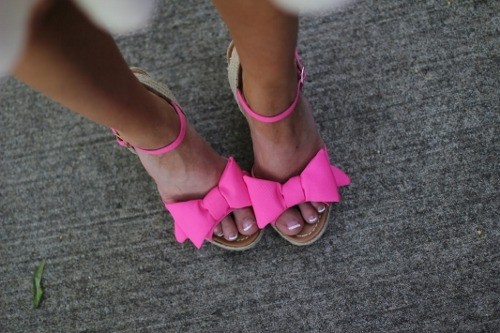
Bunions, as stated earlier begin developing when the big toe starts deviating towards the second toe and the base of joint bends outwards. Over time, the protruding joint at the base of the big toe starts resembling a claw and the shape of your foot starts changing.
The changing foot anatomy can cause the other less affected toes to bear more weight than usual. It is seen that bunions may result in increased stress fractures or painful calluses under the ball of the foot. Sometimes bunions can lead to infections or ulcerations.

Anyone can develop a bunion, but this condition is more common in women. Likewise, people with weak foot structure or bones can develop bunions. Bunions that develop in adulthood can get worse with aging. They are also seen to be painful in people with arthritis.
Poorly fitting footwear especially pointed shoes and high heel can result in bunions. This is because these shoes push your foot bones into an unnatural shape.
Bunion Causes And Anatomy Of The Big Toe
Your big toe is made up of two joints. The larger joint is called the MTP and this is where the metatarsal or the first long bone of your foot meets the first bone of your big toe. Bunions developed when the MTP joint moves out of place.

What happens is that the long foot bone starts shifting towards the inside of your foot and the bones of your big toe start angling toward the second toe. As a result, the MTP joint or the point where the bones meet becomes larger and it starts protruding from the inside of your forefoot.
Interestingly the word bunion itself comes from the Greek word ‘bunion’ used for turnips. This is because the bony bump that appears on the side of your foot appears red and swollen like a turnip.

Remember that the bone at the base of your big toe connects to the bone in the ball of the foot. Normally the two bones involved align in a straight line and this is the reason your big toe points straight ahead. However if the MTP joint becomes faulty, the big toe starts to turn inwards and this pushes the joint out to the side. This bump or the bunion can be mild, moderate or even severe.
What Is A Mild Or Moderate Bunion?
Mild and moderate bunions appear as small bumps on the side of the foot. You would find this bump at the base of the big toe. On the other hand, a severe bunion appears as a huge bump and the big toe might even move under the second toe.
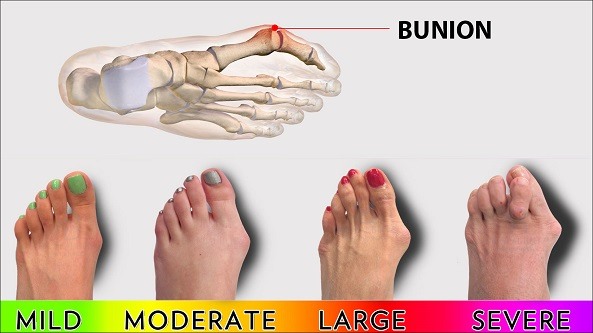
Bunion Progression
If you develop a bunion, you would notice a tiny bump as the big toe angles towards the second toe. However even though bunions start small, they usually get worse over time especially if you continue to wear tight, narrow shoes.
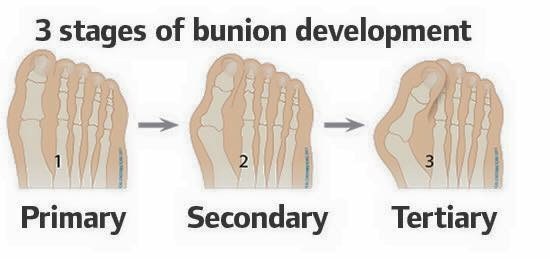
In severe bunions, the excessive pressure coming from the big toe might greatly alter the appearance of the foot. In fact, the big toe can change the alignment of the second and even the third toe. Calluses may start developing at the points where the toes rub against each other and this causes additional discomfort while standing and walking.
Your doctor would take an x-ray of your foot to determine how severe a bunion. Healthcare professionals determine the HALLUX VALGUS angle (HVA) i.e. the angle between your big toe and the first long bone in your foot (metatarsal) for accurate diagnosis.
Are You At Risk?
Anyone can get a bunion, but some people are just more prone to the condition.
1. Wearing Poorly Fitting Shoes
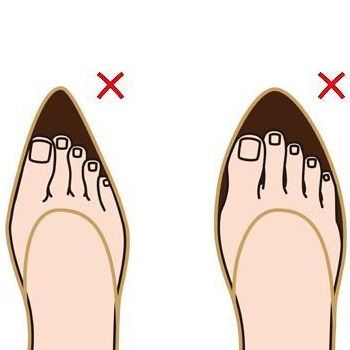
You can blame your poorly fitting and tight shoes for triggering a bunion, but they’re not always the underlying cause. Sadly, high heels can exacerbate the condition because they force you to balance your entire body weight on the fore foot. Wearing high heels and pointed shoes is one reason why women are more likely to end up with bunions than men.

2. Family History And Genetic Link
Yes, bunions do have a genetic link because the type of your foot including its structure and shape is strongly linked to your genetic makeup. People with flat feet and those with loose joints are at an increased risk of developing the condition. Similarly, a person with family history of bunions is at an increased risk of developing them.
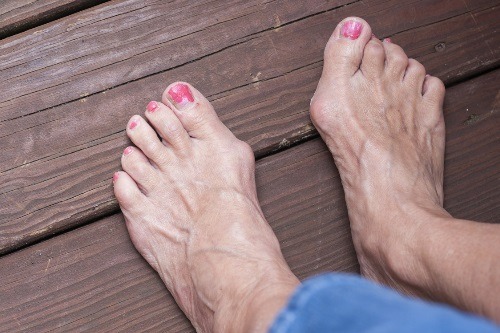
It is also important to note that low arches and the shape of your metatarsal bone makes a significant difference. If your first metatarsal bone is too round, the joint at the base of your big toe is unstable and this makes it more likely to deform or go out of alignment if you try to squeeze your foot into shoes with narrow toes.
3. Bunions And Work
If you’re involved in occupations that involve a lot of standing or walking, your feet are more susceptible to bunions. Ballet dancers in particular have the highest risk of end up with bunions because their feet endure constant stress.
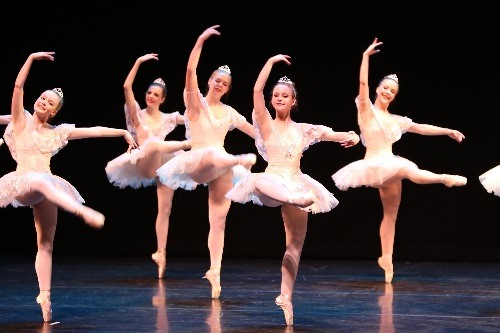
You should consider informing your employer if any changes in foot anatomy should affect your performance at work. Remember that an informed employer will be able to support your changing ‘job responsibility’ at the workplace.
Of course, people with bunions are able to carry their normal tasks without significant adjustments but it some cases, standing or walking for a long time might be an important factor. Depending on the nature of your job, you can talk about bringing correct footwear, medication, icepacks and padding support to work. On a separate note, you need to consider if you still meet the occupational requirements for driving or operating heavy machinery.
4. Pregnancy
Women might develop foot problems during pregnancy because of the hormonal changes taking place inside their body. Fluctuations in hormone levels might cause flattening of the feet and loosen the ligaments that hold the MTP joint in place.

5. Bone Conditions
Bunions are strongly associated with arthritis and other joint conditions where there is cartilage damage. The good news is that you might be able to prevent bunions by taking preventive measures and taking off excessive pressure off your joint.
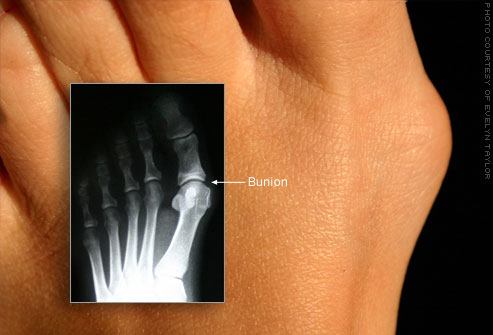
You don’t really require extensive surgery unless there’s serious underlying deformity. More details on lifestyle changes and surgical options that can prevent bunions from progressing are coming up later in the post.
Foot Problems Related To Bunions
Faulty MTP joint sometimes leads to bursitis, a painful condition in which the tiny fluid filled sac that protects the bones near the base of the toe joint becomes inflammed. This inflammation of bursa or the protective cushion might also lead to chronic pain and arthritis if the joint gets damaged due to not gliding smoothly.
Adolescent Bunions
As the name suggests, this condition is most common in young adults. Young girls particualry between the ages of 10 and 15 are affected by adolescent bunions.
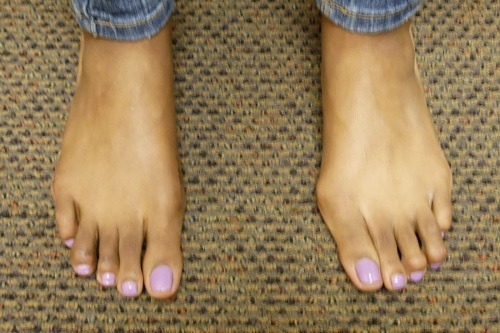
If you develop adolescent bunion, you might be able to move your MTP hoint and the big toe but the movement would be painful. Also, it might be difficult to wear shoes.
Unlike adult bunions, adolescent bunions are not associated with wearing tight or poorly fitted shoes. They are often genetic and tend to run in families.
Bunionette
Also known as "tailor's bunion," a bunionette develops near the base of your little toe. Even though the defomity is at a different spot, a bunionette is quite similar to a bunion. It is also likely that you develop callus or painful bursitis at the affected site.
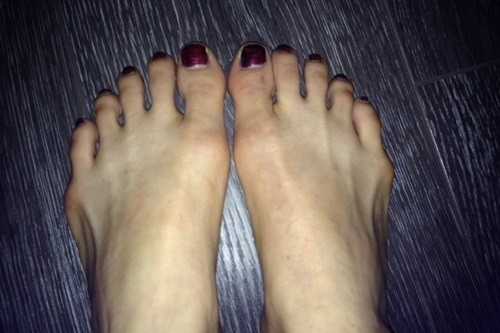
To Sumarize
Bunions may be caused by:
- Wearing tight or poorly fitting shoes. If you want to avoid adult bunions in particular, stay away from high heels and narrow footwear that forces your big toe into an unnatural position
- Faulty genes. There are chances that you inherit genes that make you more likely to develop bunions due to the shape and structure of your feet.
- Painful joint conditions such as rheumatoid arthritis or nerve conditions affecting the foot can increase your risk of developing bunions.
Why Bunions Need Attention?
You know that your big toe bears and evenly distributes your body weight during a number of routine activities. When the base of your big toe joint becomes painful and moves out of alignment, this change seriously affects the ligaments, tendons and bones in the area. Your normal foot functioning might be affected and you may not be able to move or walk around easily.
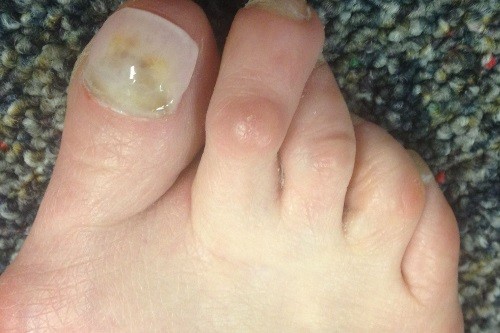
It is also important to remember that a bunion on the big toe can damage other toes as well. The constant pressure exerted by the big toe might lead to corns or hammertoes on your second toe. Similarly, you would notice that your toenails become ingrown and there are a large number of calluses at the bottom of your foot.
It is also likely that you constantly shift your body weight off the painful big toe to other toes, which may lead to pain and discomfort in the ball of the foot. As bunions progress, the misaligned joint becomes more painful and uncomfortable and eventually your feet might no longer fit into shoes.

Especially in older people, bunions and related foot problems are the major cause of sedentary lifestyle. Harvard Medical publication states that the more severe the bunions are; the lower is the quality of life.
Signs And Symptoms Of Bunions
The signs and symptoms of a bunion include:
- A prominent bump on the side of your foot, right at the base of your big toe
- The bump is usually swelled. It might also appear red or sore.
- The big toe joint is often painful to touch.
- You may find calluses and even corns at the spot where your first and second toes overlap
- Severe pain and discomfort at the base of the big toe
- You might be unable to move your big toe if the joint is affected by arthritis.
When Should You See A Doctor?
You don’t really require any medical treatment if you develop bunions, but you can see a doctor who specializes in foot disorders if you have:
- Persistent pain in the big toe
- You are unable to move your big toe joint
- Your foot movement is affected
- You are unable to find shoes that fit properly
Diagnosis
Your doctor can easily tell if you have a bunion by looking at your big toe. In some cases, your healthcare provider might recommend x-rays to rule out the possibility of arthritis and other joint conditions.
If bunions are diagnosed, you should start wearing shoes that fit properly and help alleviate the pain. Using shoe support and icing the big toe may also help reduce pain. If bunions are extremely painful, you can ask your doctor for more information on getting them surgically corrected.
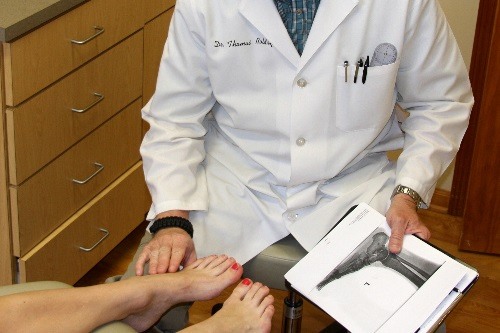
You also need to remember that bunions are progressive and they don’t go away. In fact, they will only get worse with time. On the other hand, not all bunions progress rapidly. Once your doctor confirms your bunion, he or she will then develop a treatment plan that best suits your needs.
Conservative Treatment For Treating Bunions At Home
The first step to relieve the pain and discomfort of bunions is wearing the right kind of shoe. Footwear you select should have a wide and more importantly, flexible sole to support your foot. In addition, there should be enough room in the part surrounding the front of your foot and toes.

There are plenty of good choices when it comes to comfortable sandals and shoes made from soft leather. If you are using shoes with a back, there should be a sturdy heel to keep your foot comfortably in place.
Having a bunion doesn’t mean you throw away your footwear. You may be able to use some of the narrow shoes with stretchers that will make room in the toe box. If you are wearing heels, make sure you choose ones no higher than an inch.
There are plenty of gel-filled pads and shoe inserts easily available at drugstores to maintain the correct position of your foot. You can also wear a splint at night to keep your toes straight and minimize discomfort.
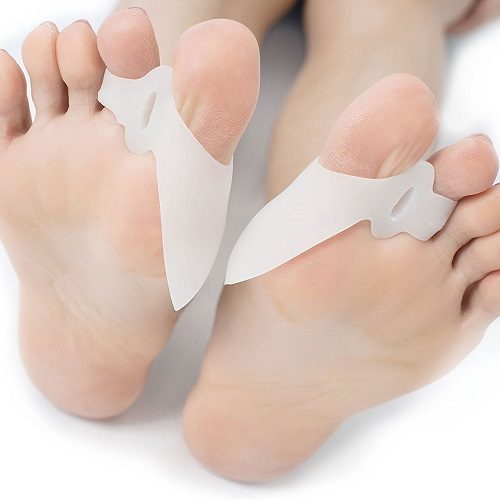
If the bunion becomes extremely irritated and painful, you can try warm soaks and ice massage. OTC painkillers such as ibuprofen and aspirin may also provide some relief. Some people decide to use cortisone (steroid) injections to relieve pain but they should be avoided as steroid medications have many side effects.
Nonsurgical Bunion Treatment – A Summary
Sometimes all you need are a few simple changes to reduce the pain and discomfort associated with a bunion. To reduce chances of damage to the big toe joint, it is recommended that you visit your doctor for periodic evaluation.
Early non-surgical treatment is aimed at easing the pain of bunions. However, they do not help reverse the deformity.
1. Changes In Footwear
Wearing the right kind of shoes is very important if you want to stop the progress of bunions. As stated earlier, you should choose footwear with a wide toe box. Shoes with tight, pointed ends and those with heels greater than a couple of inches should be avoided at all costs.
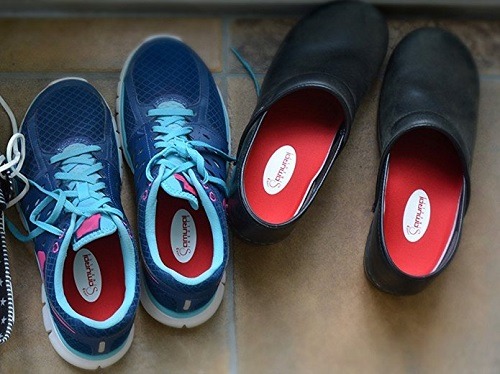
2. Pads
You can purchase gel-filled pads from your doctor or local drug store. These pads when placed over the swelled and irritated area can reduce the pain and discomfort.
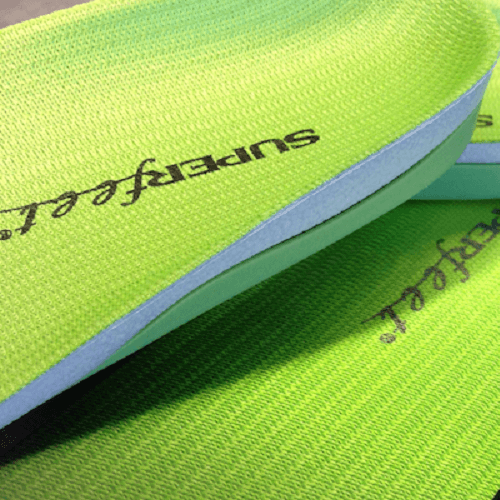
3. Lifestyle Modification
It is better to avoid strenuous physical activity such as standing or walking for long periods of time that might increase bunion pain.

4. Painkillers And Ice Massage
OTC non-steroidal medication such as aspirin and ibuprofen can be used to temporary relief pain and inflammation. Applying ice packs on the bunion several times a day also helps reduce pain and swelling.

5. Orthotic Devices
You can get custom orthotic devices from your doctor, which will help minimize chances of bunion progression.
How To Relieve Bunion Pain – Some Quick Advice
Here’s something you need to remember. Most bunions are treatable without surgery. That’s right, if you want to prevent joint damage and reduce bunion pain and inflammation, make sure you choose comfortable shoes that conform to the shape of your feet.
It is recommended that you select shoes with soft soles, adequate heel support and broad toes. Make sure you avoid shoes that are too tight or sharply pointed. You need to get rid of footwear with heels higher than 2 ¼ inches!
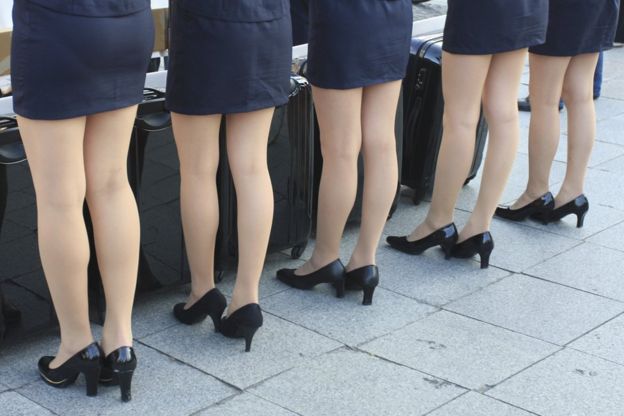
If your bunion is progressing rapidly, make sure you wear shoes that are big enough to accommodate the misaligned joint and don’t put too much pressure on it. Some people have their shoes stretched out professionally and use protective padding to cushion the inflamed area.
Unfortunately, if your bunion has progressed to the point where you cannot stand or walk normally despite comfortable shoes, you may require surgical correction. Your doctor can provide you with more information about bunion surgery that is helpful for realigning bones, ligaments and tendons in the area. The good news is that most bunion surgeries are now done same-day basis, i.e. you don’t require staying in the hospital for a long period.
How You Should Select Footwear
We compiled some tips on how you should select your footwear. Check them out below.
Tips For Proper Shoe Fit
Tight or poorly fitting shoes can worsen an existing bunion. Because bunions can progress rapidly, it is important that you choose footwear that fits correctly. Make sure you avoid shoes that are too tight or sharply pointed.
Ladies should avoid heels higher than a couple of inches. Remember that high heels and pointed shoes put additional pressure on the forefoot and increase your risk of permanent joint damage or injury.
Here Are Some Tips That Will Help You Find Shoes That Fit Correctly.
- Always judge the fit by how it fits on your foot. Don’t select shoes online or use the standard sizes marked on the inside of the shoe.
- Footwear you choose should fit as snuggly as possible to the altered shape of your foot.
- Make sure you have your feet size measured regularly and always fit the shoe to the largest foot. Yes, majority of people have one foot slightly larger than the other.
- You may be tempted to buy trendy pointed shoes, but you need to understand that they squeeze your forefoot and toes. You should instead look for shoes with roomy toe box.
- Always buy shoes at the end of the day when your feet are the largest. Stand and walk around during the fitting process to check that there is sufficient room to move your longest toe. That’s right. The shoes you choose should have enough room for you to wiggle your toes.
- The ball of your foot should fit correctly into the widest part of the shoe.
- If the shoe doesn’t stretch or feels too tight, try a different pair.
- Your heel should fit correctly in the shoe without slippage. Simply put, your shoe should grip your heel firmly so that the shoe doesn’t flop when you walk. In addition, heel height you choose should be low.
Useful Foot Exercises For Bunion Pain Relief
Bunions, as you are aware happen when the joint at the base of your big toe becomes swollen and forms a huge, painful bump on the side of the foot. Having a bunion definitely is not the most pleasant experience and most cases; it may eventually lead to joint conditions such as arthritis.
You can now manage the majority of bunions without surgery. There are special foot exercises you can perform everyday to relieve the painful symptoms and increase the flexibility of your big toe joint.
What Are The Benefits Of Foot Exercises For Bunions?
Simple foot exercises can slow down the progression of bunions. Remember, you should always start with conservative home treatment and never jump into bunion surgery. Physical exercises and toe stretches help maintain joint flexibility and strengthen the muscles that control your big toe.
Here are some simple exercises that you can perform at home and prevent the progression of bunions. These stretches are the best strategies to begin before involving surgery.
1. Toe Stretches
Stretching out your toes keeps them pointed straight and this move is especially helpful in reducing the pain. For this exercise, point your toes straight and hold the position for about five seconds. You can then curl the toes for the same amount of time to complete one rep.

Make sure you perform toe stretching at least ten times.
Toe stretches are quite beneficial for people who have hammertoes or other joint complications in addition to a bunion.
2. Flexing And Contracting The Toes
Flexing and contracting the toes while being pressed against a hard surface is another useful exercise that you can try at home. Press your toes against a wall and at the same time, try to flex and stretch them for about 10 seconds. Rest for a couple of seconds and then repeat the process four to five times.

3. Big Toe Stretches
Use your fingers to gently bring back your big toe into proper alignment. Make sure you go slowly and hold the position for about 10 seconds. You can repeat the exercise three or four times in a day.
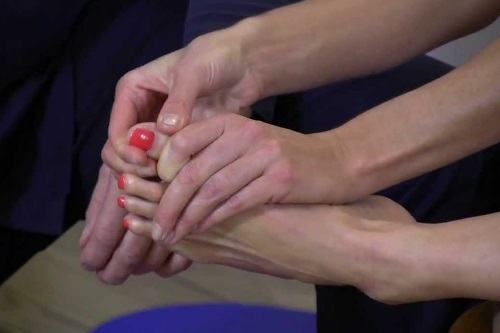
4. Resistance Exercises
Doctors recommend resistance exercises for easing bunion pain and this can be achieved by using a belt or towel for pulling the big toe. All you have to do is wrap a comfy towel around the big toe and gently pull your toe towards you.
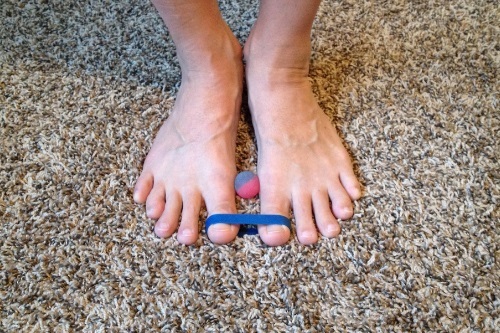
5. Tennis Ball Roll
While remain seated on a chair, place a small tennis ball on the floor and turn it around using your foot for about 2 minutes. You can even use a golf ball under your foot to relieve cramps and painful foot strains.
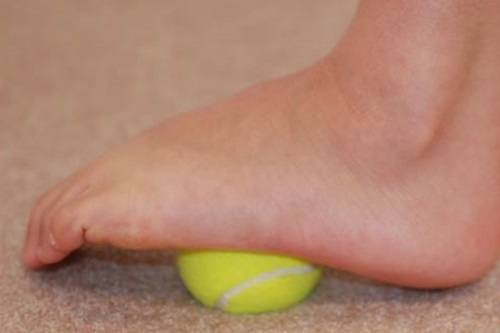
6. Walking On Sand
It’s no secret that walking barefoot on beach has its appeal. Nevertheless, spending some time walking on the relaxing beach can massage your feet gently and strengthen the toes. Walking on sand is also recommended for people that develop bunions as a result of arthritis.
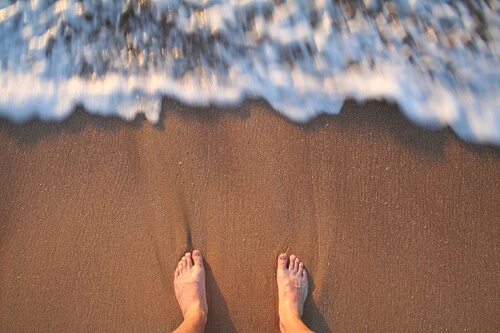
Interestingly, when you feel the mild struggle while taking a step forward in dry sand, your foot muscles are at work. The energy your body utilizes while walking on sand helps strengthen all the muscles in your feet including your glutes, quadriceps and calves.
7. Picking Up Marbles
Place 20 random colored marbles on a flat surface in front of you and try picking them with your foot. This gripping exercise is excellent for your feet and at the same time, you can improve the mobility and flexibility of ligaments, tendons and muscles in your feet.
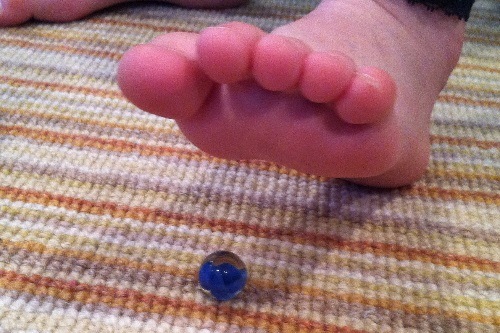
8. Towel Curls
To do this, spread a small towel on a flat surface in front of you and curl your toes gently around it. Now try to pull the towel towards you and repeat the step 5 to 6 times. Gripping towels or other objects with your toe can keep your joint flexible and slow down the progression of bunions.

Do Over The Counter Bunion Products Actually Work?
When people first develop bunions, they immediately reach for easily available remedies to control the pain and inflammation, which accompanies the deformity. After all, you don’t need to jump into a surgery right away.
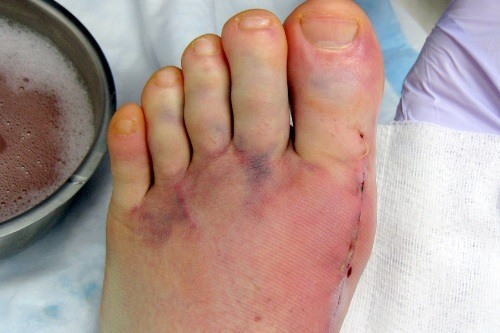
If you try to find remedies to fix bunions, you are likely to come across an overwhelming number of ‘foot’ support products. At this stage, it is important to understand that your condition is the result of certain problem in the foot anatomy and each person has unique symptoms.
Some people develop painful bunions in early adulthood that require surgery and there are people who live with small bunions for the rest of their lives. So the question is – what are your choices when it comes to over the counter bunion products?
Well, the list of useful products can be pretty long but let’s limit it to some of the most common products. Remember that while these products can slow down bunion progression, they do not correct your joint deformity. In addition, if a product works for your friend, it might not necessarily work the same way in your case.
Bunion Splints And Braces
Bunion splints are the most effective products because they help hold the big toe in place. Some splints are rigid and can only be used at night. You can also find flexible splints made of fabric, which can easily be used during the day. These products can be worn inside your shoe.
Ideally you should start using bunion splints for 20 minutes a day and then gradually increase the time. If you experience severe discomfort, you should try to reduce the tension of the straps – Splints have a loop like structure, which actually holds your big toe in place.
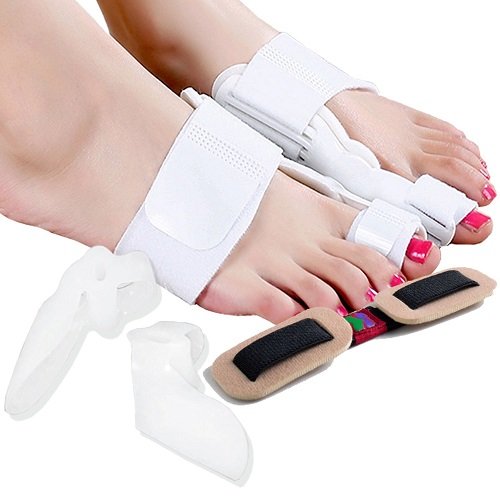
Some splints are flexible and allow you to correct the misalignment of the toe while your foot moves during sleep. Again, you have to remember that every person is different and that you might see improvement in toe alignment after 6 to 7 weeks.
Splints have a brace that is placed along the inside of your foot and the straps are used to align your big toe. It is important to have correct alignment of the toe while walking because the position and alignment of your big toe affects the movement of your knee, pelvis and hip joint.
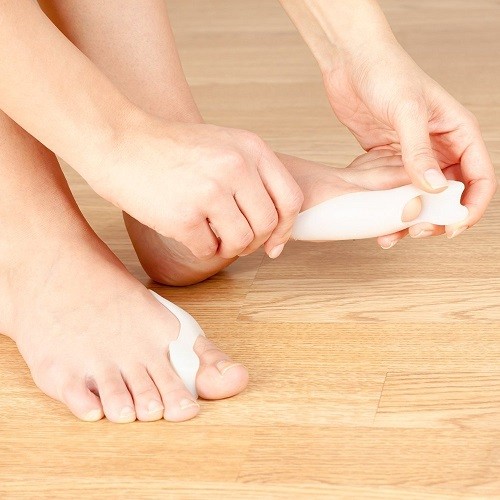
If you experience pain after using the bunion splints, there are chances that you adjusted the toe strap too tightly or you are wearing the brace for a long time. For best results, start wearing the splint for about 20 minutes first and once you get comfortable, increase the amount of time you wear the splint each day.
Bunion splints are excellent remedies for mild to moderate bunions. If you are able to move your big toe into a corrected position by using minimum force, your foot is most likely to respond to bunion splints. Compliance however is the most critical factor for success in this case. You should wear the splint for the recommended amount of time during your daily activities.
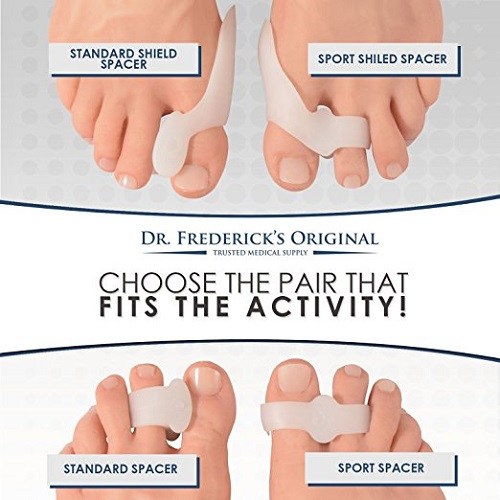
There are several varieties of bunion splints with some options being more rigid than the other. Remember it’s crucial that you find a product that’s comfortable for your foot because you will be wearing it for several hours during sleep. In addition, you’ve got to remember that bunion splints don’t work overnight. You may notice pain alleviation, but you do require 6 to 7 weeks for your joint to move back into normal alignment.
Bunion Protective Pads And Cushions
Because a bunion is the result of joint misalignment, protective cushions can be used to limit bunion progression and manage the symptoms.

Most painful symptoms of bunion involve pressure and friction created by the shoe pressing against the bunion area. This constant pressure and friction leads to intense pain, irritation, swelling, redness and blistering. By placing bunion cushions or protective pads between the misaligned joint and skin, you can alleviate the irritation.
Should I Consider Bunion Surgery?
Well, the decision to proceed with bunion surgery is different for every patient and requires careful evaluation. You doctor will consider several factors such as the size of the bunion and your medical condition before deciding the surgical method for correcting it.
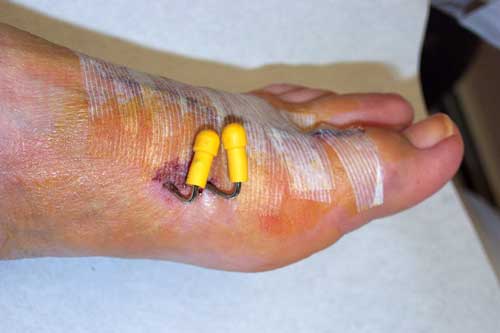
As you can guess, treating a smaller bunion surgery is less work when compared to treating a large, painful bunion. Once the surgery is performed, you require vigilant preventive care to eliminate the chances of reappearance of a bunion.
Bunion Prevention – What You Can Do
The best way to reduce your chances of developing bunions is to wear proper shoes. Simply put, you should avoid shoes that are too tight or have high heels and pointy toes. Roomy shoes that have spacious toe boxes are ideal footwear along with low or flat heels.
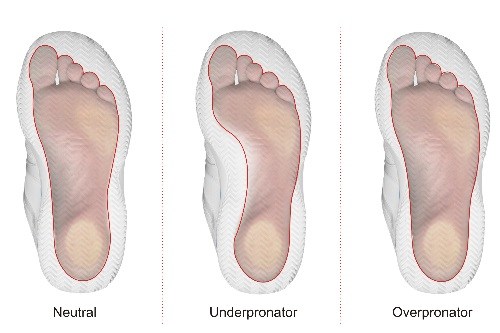
You can also prevent bunions by preventing too much inward rolling of the foot during walking and running. Medical experts suggest that excessive foot pronation can lead to bunion formation and you are able to prevent this by wearing arch supports or by using supportive shoes. If excessive pronation is not corrected by wearing corrective shoes, you can ask your doctor for having custom orthotic shoe inserts made for you.
Conclusion
If you have bunions or know someone who suffers from condition, it is important to remain calm. Here’s hoping that the tips and suggestions mentioned in this post will help you reduce the pain and discomfort associated with bunions and live a pain-free life.

